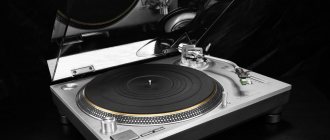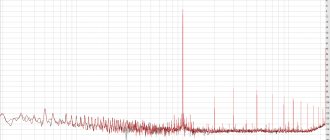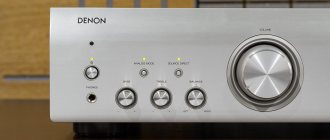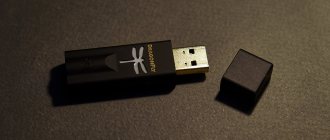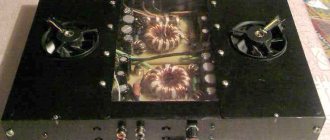Some time ago I tested the Music hall mmf 2.3 player, the youngest turntable in the company’s catalog. After which it is quite logical to tell readers about the model one step higher - mmf 5.3, especially since this is also an updated version, replacing mmf 5.1. And in this test I will look for similarities and differences more than usual, because the tests, although published with a decent spread in time, were carried out simultaneously, and I was able to evaluate both players at once.
Table in several layers
You can immediately see that the player belongs to the Music hall lineup. And all because model 5.3 is the first in the manufacturer’s catalog to feature a proprietary design – a table made up of several layers. The meaning of this technology is as follows: different parts of the player are attached to different levels of the table, and the plates themselves that make up these levels are separated from each other using elastic cone-like polymer inserts.
Vinyl record player Music hall mmf 5.3
There are three versions of the Music hall mmf 5.3 model: the “basic” player, finished in black or white varnish, the le version (which I just got for testing) in red varnish, and the se version, in which the bottom plate of the table is finished with black varnish, and the top - veneer. In addition, the se version also comes with a higher-level head - not Ortofon 2M Blue, but Ortofon 2M Bronze.
The player in red varnish looks very impressive. To be honest, I personally don’t like red varnish, but in this case the tone was chosen correctly: the color does not cause rejection. And the quality of the varnish is high. I got the impression that it has a better lacquer finish than the previous 5.1 model.
Two chassis levels. Also in the photo you can see the elastic cones connecting the upper and lower plates
The legs of the player are exactly the same as those of the mmf 2.3 model - two metal parts with a rubber insert pressed between them. And the mount is exactly the same - threaded, with the possibility of adjustment, for which a small liquid level is built directly into the table - a very convenient little thing. As a result, you can install the player correctly in just a minute. Of course, if you want perfect accuracy, then the level should be larger, and it should be located directly on the player’s disk. However, for this device the accuracy is sufficient.
Signal connectors and power supply connector for the Music hall mmf 5.3 player
Support legs and a motor are attached to the lower level of the table. There is also a connector for connecting the power supply and a shielded box on which RCA signal connectors and a ground terminal are attached. But the tonearm is not connected to the lower level of the table in any way; thin signal wires pass through the hole without touching the table.
Vinyl player Thorens TD-148A (Ortofon2M Blue) highgloss walnut
Vinyl player Thorens TD-148A (Ortofon2M Blue) highgloss walnut
Thorens is proud to present the new fully automatic turntable TD 148 A, which immediately occupies a top position in the company's catalog in its class. Combining Thorens signature style with the latest trends, the TD 148 A is a top-of-the-range turntable capable of satisfying the expectations of even the most demanding customers.
Thorens TD 148 A is equipped with a proprietary straight tonearm TP 92, which is mounted on a precision bearing. Since the effective tonearm length of the TD 148 A is slightly shorter than the original, the cartridge head must accordingly be adjusted to the new height. The Ortofon2M Blue pickup is pre-installed on this turntable.
The support plate is made of tempered glass and is mounted on a classic belt drive, which was specially adapted for the TD 148 A.
Setting up the TD 148 A takes just a few minutes: the platter must be placed on the axle, the dust cover must be in place, the tracking force and anti-skating adjusted according to the owner's manual. The belt is already pre-installed at the factory.
The TD 148 A is designed for fully automatic operation. After pressing the lever, the disc begins to rotate, the tonearm rises from the holder and moves the needle to the disc track, and at the end of playback it independently returns to its place and the engine stops. A manual control option with automatic shut-off is also available.
In the Thorens catalogue, the new TD 148 A now occupies a leading position in the class of fully automatic turntables, and is completely unrivaled on the market in terms of performance and quality.
The sophisticated appearance of the TD 148 A is further emphasized by elements such as a tempered glass support platter, an aluminum subplate and a housing made entirely of MDF.
The Ortofon 2M-Blue moving magnet pickup installed on the player was developed jointly with the Danish company MollerJensen Design - it also took part in the creation of top-end MC heads from Jubilee and Kontrapunkt. The idea was to create a cartridge whose shape resembled the facets of a diamond, reflected when moving along the groove of a record. The name of the cartridge plays on two ideas, an emphasized connection with modern trends, where the number 2 came from, as well as the fact that these cartridges belong to the type of moving magnets (MM) MM, i.e. two “M”.
And no indicators
The turntable's motor is 15-volt DC. It is fixed inside a special casing. Remote power supply in the form of a plug-adapter. There is no provision for any speed adjustment. There is also no gear change: to switch to a speed of 45 revolutions, you need to remove the main disk and move the belt on the motor pulley. Judging by the strobe readings, the drive is operating stably.
Motor and bearing cup
What I like about Music hall players is the absence of LEDs, indicators and the like. Of all the controls, there is only a motor switch located on the bottom surface of the player.
Rotation from the motor pulley is transmitted to the plastic subdisk using a flat belt. Externally, the subdisk is exactly the same as on the younger model, but the design of the bearing is different: the walls of its bronze cup are thicker, and the body is fixed without additional metal parts to the upper level of the player table. The bearing pulley is also slightly different in appearance and functionality - the part that is used to center the plate has a thread, and the kit includes a light screw clamp that is attached to it.
Subdisc and belt
The player's disk is metal, chiseled and quite heavy (definitely heavier than one would expect from its appearance). The whole structure is complemented by a felt mat, which, although it can slide over the disc when cleaning dust, if you fix the record with a clamp, there will be no more difficulties.
Ortofon 2M Black LVB 250
This year, in celebration of the 250th anniversary of the birth of Ludwig Van Beethoven, Ortofon announced the release of a new exclusive model, the 2M Black LVB 250. The flagship model in its series, the 2M Black cartridge from Ortofon is recognized as one of the best MM cartridges in its class. . It has an “open, fast, detailed, full of life and musical sound,” according to Audio Beat magazine. However, Ortofon decided to make this great model even better. The 2M Black LVB 250 was developed based on the 2M Black design, but its characteristics have been improved to achieve true technical excellence. The 2M Black LVB 250 features a Shibata-ground solid diamond on a boron stylus, a combination found in the high-end Cadenza Black MC pickup. The thin, polished Shibata stylus profile provides a very wide contact area with the walls of the audio track and ensures excellent sound detail as well as an extended frequency range.
The use of a rigid, lightweight boron needle holder further enhances sound clarity, speed and detail. To achieve an optimal interaction between compliance and damping, a new rubber compound has been developed for the 2M Black LVB 250 cartridge suspension system. It is based on multi-walled carbon nanotubes (MWCNT) and provides the required mechanical properties necessary for optimal damping and improves the overall performance of the cartridge. . In addition, the new MWCNT compound is environmentally friendly to produce. MWCNT is in rubber polymer form rather than powder form, making the production process cleaner, with less pollution and increased energy savings. With an optimum weight of 7.2g and compliance of 22µm/mN, the 2M Black LVB 250 is compatible with most modern high-end tonearms, including the High End. This cartridge is designed for the most demanding audiophiles in terms of sound quality and can be used on the most advanced vinyl players.
Main features of the Ortofon 2M Black LVB 250 model:
- Impressive, distinctive design
- Boron needle holder
- Diamond needle with Nude Shibata profile
- Wide frequency range, accurate tracking
- Possibility of quick needle replacement
Everything is already set up
Also on the top level of the table is a tonearm. The base of the tonearm is recessed downwards, and for this reason the design is distinguished by one small feature. To unscrew the screw that allows you to adjust the tonearm height, a special shortened hex key is supplied. Don't lose it, because you can't get to the screw with a regular, non-shortened wrench. Otherwise, the tonearm is quite easy to use and set up - all adjustments are present, including the ability to adjust the azimuth.
Tonearm base
The tonearm is quite reliable, easy to use and has all the necessary settings. The tonearm itself is recognizable as a 9-inch carbon Pro-Ject, but with some modifications to the basic design. Nobody hides the fact that tonearms for Music hall are made by Pro-Ject, but differences can always be found in the designs, since these are not purchased parts, but custom-made products according to original specifications and supplied exclusively to Music hall. For example, the shell is similar in appearance and functionality to its Project version, but it is made of metal and is not a direct extension of the carbon tube.
Tonearm swivel assembly
The complete Ortofon 2M Blue head with which the device is supplied is pre-installed at the factory, and the tonearm is already configured. Of course, I checked the settings - everything is correct and nothing needed to be changed. The only thing you need to do during assembly is to hang the anti-skating weight in the position in which it should be, based on the parameters of the head. The procedure is simple and will not cause any difficulties if you follow the instructions.
Music hall mmf 5.3 vinyl record player with dust cover
In general, the design of the player is neat; the layered chassis system at Music Hall has also been around for several years, and if this is the case, it means the developer is confident in it. The only thing I didn’t really like was the way the player cover was secured. The hinges are reliable and comfortable, and the lid is not a superfluous thing. But there is one thing, and it has to do with the two-layer chassis. The fact that the inserts between the layers are springy can be easily verified by unscrewing the transport screws. Or just squeeze the edge of the table with your hand. The material of the inserts is absolutely elastic.
And the lid is attached to the top layer, and if it is open, and good bass is walking around the room, then we can assume that some of the vibrations will be transmitted from it. It is clear that this is a special case, and in practice it will be difficult to feel the impact. However, I would still advise removing the lid while listening, or vice versa, closing it. You can find a lot of discussions about the parasitic influences of covers, however, in reality, cases where this is truly critical are very rare.
Ortofon 2M Blue head pre-installed on Music hall mmf 5.3
The Ortofon 2M Blue head is quite good for its class, so I don’t see any point in trying to change it right away. And if you experiment with anything, it’s with interchangeable mats. In the last test, I really liked the properties of the Music hall Cork mat, but in fact, two mats were brought to the test - in addition, Aztec blue mat. It is more expensive (7,000 rubles instead of 3,500 rubles) and trying it with a younger player was somehow illogical, but with an older player it is necessary to conduct an experiment - it would be interesting to understand what the difference is and how justified the potential upgrade is from a cost point of view. But first you need to listen to the player in its basic configuration.
No reason to doubt
Typically, anniversary or personalized series fell into the older segments of the model range - and therefore these were MC-type heads. An understandable approach, but in our case everything is different: the Ortofon 2M Black LVB 250 was based on the manufacturer’s senior MM head - Ortofon 2M Black.
The model is not new at all and has proven itself quite well in the segment of expensive MM cartridges. Quite often, 2M Black is used even by owners of expensive systems, where there are several MC options.
The fact is that 2M Black works well on worn plates and plates with surface damage, which is quite natural for a Nude Shibata needle on a movable and pliable needle holder. And using them in parallel allows you to listen to problematic records and save much more expensive heads.
Ortofon 2M Black LVB 250
In addition, there is another, special area of application for 2M Black - records with heavy rock and metal. After all, these cartridges have excellent dynamics, good detail and the ability to pull sound out of the mess. The aftersound and air are still somewhat different from MC heads - but who would listen to them in such genres! Rate of fire, legibility and pressure are much more relevant here.
And this model became the basis for the new version, modification LVB 250. Let’s look at the technical differences. Externally, there are not many of them, but there’s not much to go on here - the design of MM heads is much simpler than that of MC heads, and there are fewer options for the flight of engineering imagination. Therefore, the “body” of the head remains the same, like 2M Black and 2M Bronze, which differ only in the replaceable inserts.
By the way, we need to make a reservation right away - for owners of 2M Black and 2M Bronze, a replacement insert will be available as an upgrade. Right now in Russia there are no replacement inserts, but they will appear in the fall.
The head is supplied with a special case with a holder - the same as for models of the Cadenza line. They are convenient to use for storing removed heads
Accordingly, all changes and differences are in the replaceable insert. The first thing that is visible both externally and according to the passport data is that the head has the same Nude Shibata needle with dimensions r/R 6/50 microns, but this needle is secured to a bur needle holder. This is a significant difference.
Many times in practice I have compared similar models from different manufacturers, differing in the needle holder, and, if there is a choice, in most cases, other things being equal, I would choose boron or sapphire. More interesting than the same sharpening, but on aluminum.
Practice with modified and repaired heads (replacing aluminum with boron) points in approximately the same direction. The same needle on a bur needle holder, for example, is used in the design of the Cadenza Black MC head. And only very senior models receive Nude Ortofon Replicant 100 sharpening.
From an applied point of view, I will say that setting up the 2M Black LVB 250 is somewhat more convenient. The needle holder is thin and does not cover the top of the diamond, making it easier to accurately position the head when installing. But there is also an observation “in the other direction”: with exactly the same sharpening of the needle, this older version is more critical of the settings in principle. And the simple 2M Black requires attention, and this version requires even more.
In terms of getting into the geometry, everything is more or less the same, but the same downforce needs to be adjusted more precisely, with smaller steps - and you can hear it. The same can be said in terms of adjusting the tonearm height. Apparently, the behavior of the heads in dynamics is slightly different. But this is not so much a question of the needle holder as of the next point of design improvements.
The protective needle cap on the Ortofon 2M Black LVB 250 is the same as on all 2M series heads. Not the most comfortable, but protects
It will not be possible to see this next element without breaking the head, since we are talking about the material of the polymer insert that dampens the needle holder. But we won’t break anything, especially since it’s just a tiny polymer part, but its physical properties are extremely important for the final result.
2M Black LVB 250 uses an unusual polymer called MWCNT, which can be interpreted as “multi-walled carbon nanotubes”. Without being a polymer specialist, this is difficult to interpret, but it is worth remembering that Ortofon has its own polymer development division and its own production.
Among other things, it supplies polymer micro-parts to many third-party companies that are not even related to the audio industry, but need precision-made miniature parts with specified and controlled physical properties. I saw this production in Denmark and it looked more than convincing. So there is absolutely no reason for doubt.
Before listening, all that remains is to tell you about the equipment. Everything here is the same as with other Ortofon heads, not counting the very oldest ones - that is, very ascetic. Perhaps the packaging is similar to the Cadenza series heads, but inside everything is the same: two pairs of screws, a screwdriver, a brush for cleaning the needle and mechanical scales. Nothing extra.
Although I would recommend using electronic scales for setting up - accuracy is more important here. And there is also a head passport with characteristics. I must say, they are quite good, but since we are talking about a MM head, everything is simpler here, and you don’t have to bother with adjusting the impedance.
Sound: recognizable features
The only thing I had to do before listening was to let the head run in a little, otherwise at the very beginning it was clearly noticeable from the bright highs and tightness of the sound that it needed “warming up”.
I started testing with the album “Ella & Duke at The Cote D'Azur”. And I heard a dynamic sound, quite bright, expressive, with good nuances and a decent stage. The dynamics are even higher than expected, however, predictably - the Ortofon 2M series heads are known for their “rate of fire”.
Music hall mmf 5.3 player with Music hall Cork mat
There is also a recognizable feature, which I also attribute to the head: a slightly raised mid-upper range and accents on the main tones. If this were combined with poor detail, the result would be bad, but here the detail is decent, after-sounds are not lost, so there is no imbalance.
Perhaps I would like more bass and more fullness and volume. However, I won’t say that there is no bass; the question is more about the usual ratios. For my taste, the balance should be a little more even.
Music hall mmf 5.3 player with Aztec blue mat
Vocal parts are played honestly - in sufficient detail, with good spatial localization, without distortions in the proportions of the stage. And what is important is that emotions are conveyed in detail, without obvious coloring and without being stiff.
Immediately on this recording, I decided to decide on my attitude towards the standard clamp. Perhaps, in this particular case, it is not bad - the air is not choked, the sound is not simplified.
Let me remind you that when fixing the clamp, do not use excessive force, otherwise you will get no benefit, but an additional distortion in the sound. But if you get used to it, the clamp can be beneficial. But I wouldn’t recommend replacing it with something heavy: heavy clamps are not suitable for this player.
Branded mat Music hall Cork mat
Let's listen further to the Eric Clapton record “Pilgrim”. The sound is enveloping, with good bass (actually there is objectively a lot of bass on this recording), an open, slightly bright middle and slightly emphasized, emotional high frequencies. The dynamics are confident, but at the same time, seemingly thorough. The sound is not slow or drawn out, but comfortable and smooth. The detail is good, although in the subtle nuances you can notice a slight simplification.
Branded mat Music hall Aztec blue mat
On this record I tried to understand the interchangeable mats and what their differences are in practice. First, I changed the standard mat to Music hall Cork mat. The sound became a little more transparent in the upper frequencies, more airy, the stage became deeper and more voluminous. I tried the older Aztec blue mat, the effect was different: the sound became more natural, delicate. But in general, the effect of both mats is not as pronounced as in the case of the younger model of the player. Therefore, I will not definitely recommend such an upgrade; all these are rather nuances and shades.
Sound: emotions and their shades
The next record is The Cinematic Orchestra “Ma Fleur”. The sound is spacious, rich, evenly mobile. The tract handled this recording not just well, but exceeded all my expectations. Emotions and their shades are perfectly conveyed. In some fragments, the nuances and after-sounds, the tiniest details, were a little lost, but the tract coped well with all the main components of the recording, bringing in very little of its own. And the specific dynamics (calmness) suited this album in a very interesting way. Overall the presentation is suitable for long and thoughtful listening.
Power supply and standard phono cable
The next disc is Brian May “Back To The Light”. The sound is harsh, flattened and dry, which is completely expected from this record. But sharpness is just sharpness; in combination with the player's own style, it does not become excessive. In terms of dynamics, the album sounds both good and a little less twitchy than it could have been. In terms of detail, the tract copes well: simplifications in nuances are audible, only in this case they relate not to the properties of the player, but to the features of a particular album and publication. In total, it turns out that the path does not amplify recording flaws so much that they interfere with listening to music. And this is a good result.
If you remove the standard mat, the player's disk will look like this
Let's move on, a record with a recording of Vivaldi's work "L'estro Armonico op.3". The sound is timbrally simpler than we would like. But the picture as a whole turns out to be plausible. Let me note: if the player works in a system of its own level, the result will be good, and no one will hear what I call “simplification” here. In this category, proper processing of the recording is more important, because distortions of this nature will be heard on any system.
The sound, although there is some sharpness and elevation in the upper frequencies, is not annoying and does not fall into the category of hard sound. Emotionally, the music is also perceived fully; the tract does not try to repaint this component.
The Ortofon 2M Blue head is equipped with a removable protective cap, but I can’t say that this cap is easy to use
And the last record in the test is a recording of “Tannhäuser” by Richard Wagner. Quite plausible detailed elaboration, simplified only in complex fragments, a slightly formal sound of the choir. And the emphasis on the highs is almost unnoticeable, and in terms of dynamics, the device coped surprisingly well with the recording. The stage, even for such a complex work, is built correctly, with good readability of images and plans. And the emotional perception of music turns out to be multifaceted and interesting.
And no questions
Before I started listening, I noticed a good sign: the head is very quiet in the background. The corrector is in MM mode, the gain is almost at a minimum, the sound is loud, but in idle mode it is quiet.
The contact group of the Ortofon 2M Black LVB 250 has a somewhat unusual layout: for most heads, the contacts of the right and left channels are located, respectively, on the right and left, while the 2M series has positive contacts on one side and negative contacts on the other. This is worth taking into account for those who are used to connecting everything automatically, otherwise you may make a mistake
At some point, I had a desire to test the head only on classical music - its varieties, in principle, would be completely enough to get an idea. But let's go the usual way. And at the end we will definitely get to the works of Ludwig van Beethoven.
The first I listened to was the album “Live At The Nordsea Jazz Festival” with Oscar Peterson, Joe Pass and many other wonderful musicians. The first impressions of the sound are that it is fast, moderately sharp and open to the listener, while there is cohesion and plasticity. And already at the first comparison, this version of the head seemed to me a little less bright than the classic 2M Black, and also more smooth and accurate. However, this was predictable.
The dynamics are emphasized, but there is no sharpness, the sound is light, but not very bright, there is accuracy in it. There's plenty of bass, but it's light and fast rather than bloated. There is no bloat at all, there is complete control, although in this part of the range the textures are not very noticeably worked out: the contours are almost impeccably accurate, but the filling is a little formal.
The middle of the sound is practically not raised, almost everything is even. But fullness and richness are present here in good quantities. I liked the highs - there is no excessive sharpness or brightness, there is dynamics, good detail and accuracy. And there is no obvious feeling of decline closer to the upper part of the range: the sound is rich enough to the upper limit of what is on the recording.
The presentation combines fluency and cohesion well, the sound is not boring at all. Although, of course, you can hear the fundamental features of MM heads. The after-sounds are slightly relegated to the background, fading out a little faster and sharper than we would like.
There is a little less subtle texture and air, but it is there, and the accents in the sound are placed differently. But the readability of instrumental parts did not raise any questions. And the stage is not bad - medium in size, correct, without distortion of proportions.
The next record is a completely different jazz: Toshinori Kondo, Eraldo Bernocchi, Bill Laswell “Charged”. The sound is very deep in bass (but there is a lot of it on the recording itself), the presentation is moderately bright, rather rhythmically dynamic than holographic in terms of space, and with a slightly smaller scale. But all this is perfectly complemented by speed, and lively emotionality is fully present - only the accents in the sound are placed differently.
Sometimes preference in reading is given to assertiveness rather than the intimacy of secondary sounds. Emotionally, the head is quite capable of processing this recording without simplifying it. I didn’t notice any obvious simplification, arrogance or vulgarity in the sound - and this was with rather forced dynamics and some brightness. If we compare it with the serial 2M Black, the anniversary version seems a little less expressive, but more accurate and more detailed. It would seem that the difference is in the nuances, but it is precisely this difference that is important.
Another jump on the jazz theme is a 45 rpm analogue reissue of Johnny Hartman's "I Just Dropped By To Say Hello". The channel division is quite strange, but that's how this recording is. All the specifics are heard, instrumental parts and vocals are well separated, the sound is full, warm and spacious.
And in terms of channel layout - in the case of such records, I often just turn on the mono mode on the preamp, and everything turns out more natural. Although the recording itself is played out in full and quite well in terms of transparency, without any simplification.
That's all that comes with the Ortofon 2M Black LVB 250 except for the specifications sheet
Another problematic record is Brian May's “Another World”. There is both a digital recording and a Picture Disc release - under average conditions you wouldn’t want to listen to this. But in our case, it’s possible. The disk is noisy during pauses, but the head copes well with it - there is less noise than usual.
The dry and flat recording is enhanced by dynamics and transparency, and here even slightly faster after-sounds are perceived as an increase in the airiness and clarity of the sound. In general, it is more logical to keep such releases as cultural artifacts, and listen to digital editions at the same time, but if you want to play the record, this version of its reproduction looks as convincing as possible with such a source.
Finally, we move on to classical music and the works of Ludwig van Beethoven. First I listened to a couple of records from the Complete Piano Trios box. Everything is clean, tidy, without any noticeable coloring - just a little bit of warmth. Quite honest in timbre and legible. There is a little less after-sound and air, but there is no mess - just harmony.
You can even listen - there will be no reason to grimace. Especially if you are already used to the head feed, and you adapt to it quickly enough, because although the difference is audible, it is still not critical. There are no obvious defects in the sound - only differently set priorities.
Ortofon 2M Black LVB 250 in packaging
The latest record is an analogue reissue of the recording of Symphonie 6 “Pastorale” Ouvertüre “Egmont” with Karl Böhm and the Vienna Philharmonic. Slender, beautiful, dynamic. And without obvious coloring.
The width and depth of the stage are quite sufficient for an orchestral piece, although the stage itself is of medium scale. Transparency and layout of plans are present. There is a slight lack of air and after-sounds, but at the same time harmony and transparency are well preserved even in complex fragments.
conclusions
In my opinion, the player turned out to be solid, with a friendly character. It is likely that the standard head can be selected with another one: Ortofon 2M is a good-quality pickup, but it is harsh and makes the sound brighter. How appropriate this is is a matter of personal preference. In general, it seemed to me that the budget head on the younger model of the player “fused” with it more closely. This assumption is also supported by the experience of installing various heads on several players of the previous generation - Music hall mmf 5.1. I remember that the same inexpensive Goldring MC heads with their smooth and dim sound were perfect for an upgrade, while the bright and harsh heads, on the contrary, led their owners to noticeable dissatisfaction with the sound of the vinyl circuit as a whole.
Level built into the body of the Music hall mmf 5.3 player
Based on how the player is used, we can probably say that it is quite versatile. Unless for those who need extreme dynamics for listening to, for example, metal or symphonic works, the sound may not be very suitable. But again, this needs to be assessed in relation to personal preferences and the sound that has developed in the system as a whole.
